
Gov. Gavin Newsom listens to Mayor Eric Garcetti in March. | Carolyn Cole/Los Angeles Times via AP, Pool
With numbers exploding, a chorus of critics are second-guessing how the California governor and Los Angeles mayor reopened businesses.
SAN FRANCISCO — It’s taken four months and 7,000 deaths for Gov. Gavin Newsom and Los Angeles Mayor Eric Garcetti — high-profile California Democrats with even higher political aspirations — to go from vanguards to nearly vanquished in the fight against Covid-19.
Newsom’s early success in the Covid-19 crisis turned into a sobering reversal Monday after the state flared into a deadly hot spot, prompting the governor to impose the nation’s most sweeping reclosure to contain the alarming outbreak.
Advertisement
Garcetti, likewise vaunted for swift action in March, warned that the nation’s second largest city is now on the brink of emergency “red” status and could face another complete shutdown.
The two leaders have been buffeted throughout the crisis by countervailing demands: businesses and local politicians clamoring to reopen and health officials warning that overly hasty moves would reverse months of painfully earned progress. But now, with numbers exploding, a chorus of critics are second-guessing how the California governor and LA mayor reopened businesses.
The disease resurgence has even deeper implications after the state’s two largest school districts announced they will keep campuses closed when the academic year starts next month.
Many California Democrats blame President Donald Trump for diminishing the dangers of the virus and focusing hard on the economy. But some here suggest that Newsom caved in too soon to business interests and allowed public pressure, rather than science, to dictate his moves.
“The desire for popularity gets in the way of making good choices in a pandemic,’’ said state Sen. Steve Glazer, a Bay Area Democrat who has repeatedly urged the governor to take “command and control’’ of the situation and not rely on a patchwork of local officials to sort it out.
Newsom on Monday shut down bars and indoor dining across California, the first time he has imposed a statewide closure since reopening the economy. In hard-hit counties with a combined 32 million residents — 80 percent of California’s population —the governor also shuttered hair salons, movie theaters, malls, churches and gyms.
Glazer wants even stricter public health controls, more testing, broader contact tracing — and tougher enforcement of rogue businesses — before loosening the reins further. That might be political unpopular, but Glazer said “that bad political instinct toward popularity is a very dangerous one when you need an adult in the room.”
For the first two months of the crisis, Newsom and Garcetti were regularly heralded for containing the virus while the Northeast saw calamitous waves of deaths and hospitalizations. The two were frequent guests on national talk shows, discussing the steps they were taking to avoid the same fate as the East Coast states.
By late April, Newsom came under intense pressure from a long list of business owners, as well as residents frustrated by limitations when the virus seemed under control. Rural counties in particular had avoided the virus more than heavily populated areas like Los Angeles, which emerged as the state’s hot spot but never suffered the depths of the New York City crisis.
Newsom resisted reopening while governors elsewhere moved forward. His first set of reopening requirements was panned by local leaders and some lawmakers as too high a bar, with criteria such as no coronavirus deaths for 14 days.
By mid-May, however, he relaxed some standards and dipped his toe into reopening by allowing indoor dining and retail pickup in some counties. Then he opened churches. Within weeks came a cascade of sectors, all the way down to bars, gyms and tattoo parlors, where social distancing is particularly challenging.
All along, he has said he was guided by science. He has pointed to counties being free to impose stricter rules. And he has described reopening as a “dimmer switch” that turns some sectors off when infections and hospitalizations grow troublesome.
“The dimmer switch goes up and down based upon changing conditions, based upon context or what you’re trying to accomplish,” Newsom said Monday. “So that’s what we’re doing.”
Public Policy Institute of California President Mark Baldassare, a veteran pollster, noted that the signal from Californians was clear: prioritize health and safety over reinvigorating the economy.
Newsom in the early days of the pandemic enjoyed an approval rating as high as 83 percent in one poll. But he may now face a reckoning from constituents who perceive that “priorities have shifted and that has been the cause of this surge,” Baldassare said.
The governor and Garcetti could also face blowback from key constituents: parents who were counting on sending their children back to school in the fall. The state’s two largest school districts — including Los Angeles Unified — announced Monday they will keep campuses closed because of the coronavirus surge. A trending refrain has been schoolkids were less of a priority than reopening bars and other social activities.
Democratic strategist Garry South, who was a top adviser to former Gov. Gray Davis and has the ear of Newsom, said it was a mistake for both the governor and mayor to reopen such establishments, permitting scenes of beachside bistros filling with crowds of maskless young people.
Enforcement, though likely unpopular, would have been easy because “they’re operating under a liquor license which the state has the power to pull,” he said. But the failure to act not only may have fueled a resurgence in infections — but sent a message to scofflaws everywhere.
Newsom’s team, however, insists he has aggressively moved to address myriad issues in the nation’s most populous and most diverse state.
“We were the first to issue stay at home. We use science and data to do that — and to create a reopening process that accounted for the diversity of the state,’’ said communications director Nathan Click. “But when the governor saw data going in the opposite direction, he took strong action to bend the curve back in the other direction.’’
Political consultant Katie Merrill noted that “a governor, an elected official can only do so much if people are not going to follow the guidance — and I think you’ve seen that in that he has periodically pleaded with the people of California: don’t go to the beaches on Memorial Day, don’t overcrowd certain public spaces.’’
Like Newsom, Garcetti has been pinched in the pandemic between conservatives frustrated by his public health orders and progressives who believe he has not done enough. And the political climate confronting Garcetti has been complicated by the protests following the death of George Floyd — with Black Lives Matter activists pressuring the Los Angeles Police Department and its chief, Michel Moore.
Garcetti, said Michael Trujillo, a political strategist in Los Angeles who advised one of Garcetti’s opponents in the 2013 mayoral race, is caught in “this perfect sandwich with right-wing conservatives on one slice of bread and hardened progressives being the other slice of bread.”
As to whether those forces are reflected in the broader electorate, he said, “That’s the question we don’t know the answer to.”
Darry Sragow, a longtime Democratic strategist based in Los Angeles, said he has seen no evidence of Garcetti suffering politically from the pandemic. Like Newsom, he was praised for his early stay-at-home order, and he has continued to provide regular updates at somber briefings.
“I think right now he’s getting very high grades,” Sragow said. However, “there are risks” to Garcetti if the crisis worsens, potentially exposing him to “a lot of frustration and anger on the part of the voters,” Sragow added.
The immediate effect of the resurgence on Garcetti’s political prospects is unclear. At least two private polls are currently in the field in Los Angeles that will test his favorability — one including only a portion of the city, one citywide.
GOP strategist Luis Alvarado, founder of a Latino-focused political consulting firm — and now an adviser to the Project Lincoln group of Republicans targeting Trump — agreed that Garcetti and Newsom have managed to walk the delicate tightrope between public pressure and political meltdown.
“I think the general feeling is that they are doing the best they can under the circumstances and pressures they’re under — as opposed to the president,’’ with polls showing that overwhelmingly Americans believe “all the blame stands with him.”
Yet when history is written, Glazer warned, the actions of elected officials will be judged not on polls, or popular opinion — but on factors that will withstand the test of time.
“A political career should not be a driver in a pandemic. So you lose your reelect — and you save thousands of lives,’’ Glazer said. “I’d say that’s a helluva tradeoff for your political legacy.”






